Here are the top financial modeling platforms for 2025, designed to simplify complex financial planning, forecasting, and analysis. Whether you're a startup, mid-sized business, or large enterprise, these tools can help you streamline workflows, improve accuracy, and make data-driven decisions.
Top Platforms and Highlights
- Visbanking BIAS: Built for banking, offers a 30% efficiency boost and 40% risk reduction with AI-powered insights and historical datasets.
- Finmark: Perfect for startups, integrates with QuickBooks and Stripe, automates budget tracking, and supports scenario planning.
- Cube: Combines Excel flexibility with advanced FP&A tools, great for mid-sized businesses needing seamless integration.
- Macabacus: Excel add-in for investment banking and corporate finance, reduces modeling errors and speeds up workflows.
- Oracle BI: Enterprise-grade analytics with AI-driven forecasts and mobile reporting, ideal for large organizations.
- Anaplan: Scalable, multi-dimensional modeling for enterprises, with machine learning for predictive insights.
- Jedox: Excel-based interface with AI-assisted planning, improving forecast accuracy by up to 40%.
- Jirav: Cloud-based, visual dashboards, scenario planning, and collaboration tools tailored for accounting firms.
- Planful: Advanced consolidation and headcount planning for multi-entity organizations.
- Domo: Handles massive datasets with real-time insights and over 1,000 pre-built integrations.
Quick Comparison
| Platform | Best For | Key Features | Starting Price |
|---|---|---|---|
| Visbanking BIAS | Banks | AI insights, historical datasets | Custom pricing |
| Finmark | Startups | Real-time tracking, scenario planning | $100/month |
| Cube | Mid-sized businesses | Excel integration, forecasting | $1,500/month |
| Macabacus | Finance professionals | Excel add-in, workflow optimization | Flexible pricing |
| Oracle BI | Enterprises | AI analytics, mobile reporting | $33/processor/month |
| Anaplan | Large enterprises | Scalable multi-dimensional modeling | $30,000/year |
| Jedox | Global organizations | AI-assisted planning, Excel interface | $45/user/month |
| Jirav | Accounting firms | Visual dashboards, collaboration tools | Custom pricing |
| Planful | Multi-entity businesses | Financial consolidation, workforce planning | Custom pricing |
| Domo | Data-heavy businesses | Real-time insights, 1,000+ integrations | $83/user/month |
These platforms cater to diverse needs, from startups seeking simplicity to enterprises requiring robust, scalable solutions. Choose based on your business size, integration needs, and budget.
Next-Level Financial Modeling with AI and Automation for CFOs with Chase Wright
1. Visbanking BIAS

Visbanking BIAS is a financial modeling platform designed specifically for banking institutions. With a massive dataset of over 5 billion records covering more than three decades, it provides historical context essential for financial analysis and forecasting. This extensive data depth and seamless integration make BIAS stand out in the crowded financial modeling space.
The platform pulls together data from various sources, including:
- Financial metrics
- Performance indicators
- Regulatory updates
- Real-time news feeds
Banks using Visbanking BIAS have reported a 30% increase in operational efficiency and a 40% reduction in risk exposure. These results underline the platform’s ability to deliver measurable improvements.
Another key feature is its flexibility in data visualization. With over 50 customizable visualization options, banking professionals can design dashboards that simplify complex financial data. Additionally, BIAS supports direct export to popular tools like Tableau, Power BI, and Excel, ensuring compatibility with existing workflows.
| Key Feature | Benefit |
|---|---|
| Multi-source Data Integration | A unified view of financial metrics, regulatory updates, and market data. |
| Historical Dataset | Access to over 5 billion records for identifying trends and making forecasts. |
| Customizable Visualizations | 50+ options to present data in a clear and tailored way. |
| API Integration | Seamless delivery of content and compatibility with third-party tools. |
With over 10,000 banks relying on it, Visbanking BIAS integrates smoothly with existing systems, delivering actionable insights that improve efficiency by 30% and reduce risk by 40%.
2. Finmark

Finmark is a financial modeling platform tailored for startup founders, investors, and finance professionals. By offering real-time, automated integrations, it simplifies financial decision-making in today’s fast-paced market.
With seamless connections to QuickBooks, Xero, Stripe, and Gusto, Finmark minimizes manual data entry and ensures real-time tracking of financial data. Norman Menz, CEO of Flare, highlights its efficiency:
"We reconcile our actuals and do a full reconciliation monthly. It takes less than an hour, and everything keeps up to date."
The platform also excels in scenario planning, providing features that give users a clear and dynamic understanding of their financial outlook:
| Feature | Benefit |
|---|---|
| Budget vs. Actuals Comparison | Automated month-end close and board reporting |
| Customizable Dashboards | Real-time visualization of key metrics and scenario comparisons |
| Hiring Plan Integration | Dynamic headcount forecasting with payroll system sync |
| Multi-scenario Management | Direct comparison of multiple financial plans |
These tools work hand-in-hand with Finmark’s integrations to improve the accuracy and depth of financial modeling.
Users consistently praise Finmark for its time-saving benefits and insights. Genevieve Ryan Bellaire, Founder and CEO of Realworld, shares:
"Finmark has saved us tons of time and stress as we've been growing Realworld - it has allowed us to better understand how decisions around a fundraise, new hire salary, or pricing strategy can impact our bottom line. It's my favorite tool to recommend."
Finmark’s user ratings back up these endorsements. It holds a 4.6 out of 5 on G2 (based on 16 reviews) and a perfect 5.0 on Capterra.
Dave Wilson, CFO at ProvenCFO, adds:
"Their out-of-the-box features enable us to build complex drivers faster, dramatically improving operational efficiency."
Starting at $100.00 per month, Finmark is a great choice for small to midsize businesses, particularly those in the B2B and SaaS sectors.
3. Cube

Cube bridges the gap between traditional spreadsheets and modern financial planning and analysis (FP&A) tools. It boasts an impressive 4.6/5 rating on GetApp, with 97% of users leaving positive feedback.
What sets Cube apart is its bi-directional integration, which preserves the familiar flexibility of spreadsheets while offering enterprise-level features. Here's a quick look at how Cube's key features are rated:
| Feature Category | Rating | Highlights |
|---|---|---|
| Profit/Loss Statement | 4.7/5 | Automated reporting and reconciliation |
| Budgeting/Forecasting | 4.7/5 | AI-driven predictive analytics |
| Chart of Accounts | 4.7/5 | Seamless ERP integration |
| Data Import/Export | 4.4/5 | Multi-system connectivity |
| Strategic Planning | 4.4/5 | Scenario modeling capabilities |
These ratings highlight Cube's ability to deliver tangible results in real-world business settings. For example, a mid-sized real estate company revolutionized its financial processes by using Cube to connect its accounting systems directly to spreadsheets. This enabled department leaders to easily create forecasts and monitor budget-to-actuals within Excel.
"Cube is allowing us to bring data to leaders easier and faster. We can provide transactional details much easier than before."
Cube integrates seamlessly with major ERP, CRM, accounting, business intelligence, and HR tools, including NetSuite, Salesforce, QuickBooks, Tableau, and ChartHop.
"I spend more time analyzing the data and making decisions vs. living in the weeds of data collection."
Pricing starts at $1,500 per month for smaller finance teams, while growth-focused companies can expect to pay $2,800 per month. Custom pricing is available for enterprise-level organizations. Although the upfront cost may seem steep, users consistently report high ROI through time savings and better decision-making.
Cube's AI capabilities add another layer of value, providing predictive forecasts and benchmarking against AI-generated outcomes. This innovative approach has earned Cube six awards in 2025, including recognition for best support, easiest admin, and financial close.
While implementing advanced models can sometimes be a challenge, Cube's responsive customer support and comprehensive onboarding process help smooth the transition. With its powerful features and user-focused design, Cube sets a high standard for financial modeling platforms.
4. Macabacus
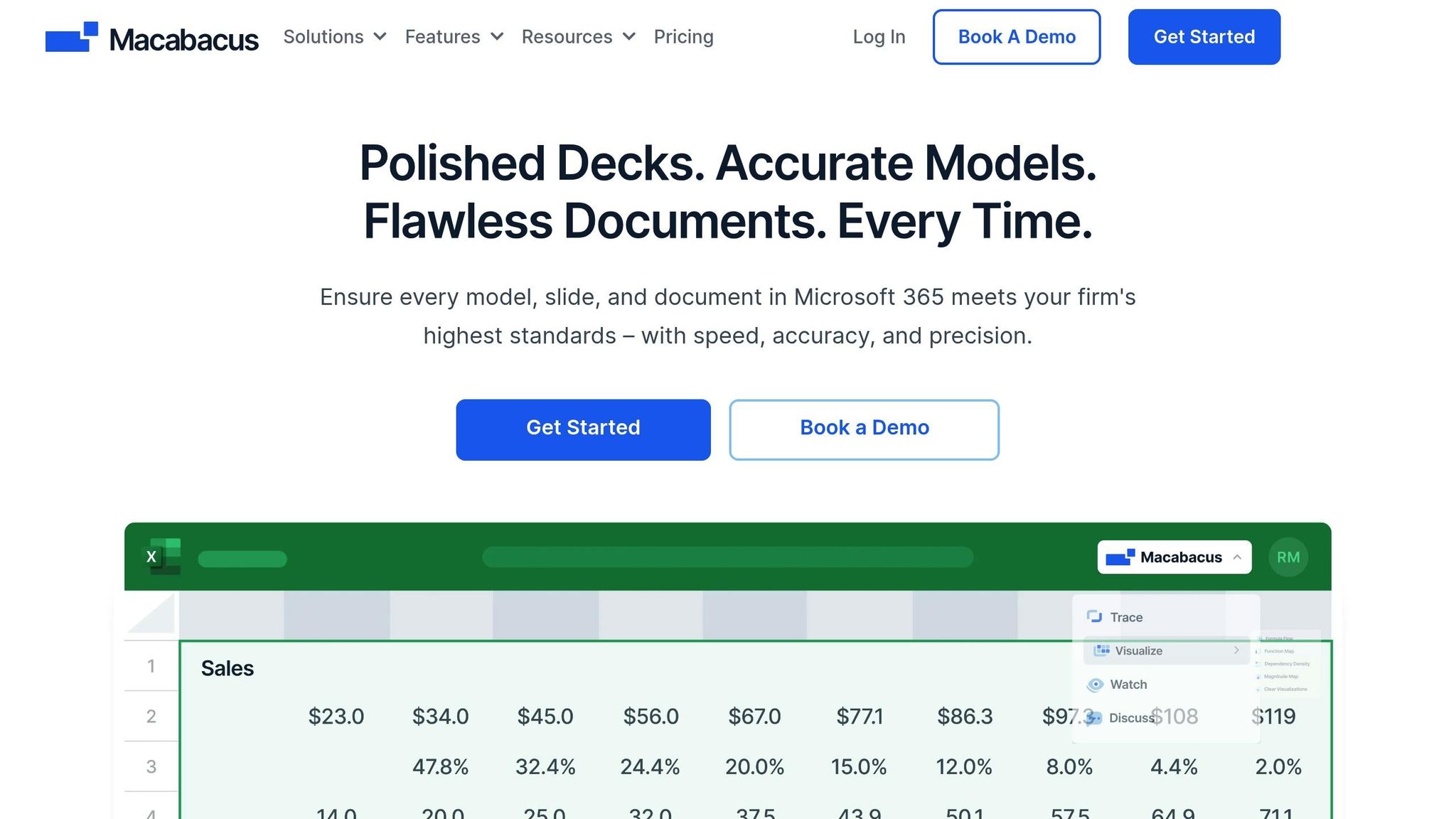
Macabacus, a Microsoft 365 add-in, is trusted by over 80,000 finance professionals across 3,000+ enterprise organizations. With an impressive 4.7/5 rating on both Capterra and Software Advice, it’s a go-to tool for investment banking, private equity, and corporate finance teams. Its widespread adoption and glowing reviews highlight its value in the financial sector.
This tool integrates seamlessly with Excel, PowerPoint, and Word, offering features like formula auditing, customizable shortcuts, and advanced power tools to minimize errors and optimize workflows. As Dave H., Director of Accounting & Business Valuations at Brookfield Renewable, shares:
"I have probably cut down on my model formatting time by 50%, and my models look better"
Macabacus also ensures smooth data flow between applications, allowing users to quickly update charts and data in presentations. Brian R. emphasizes its impact:
"I argue it has the highest ROI of any software we have at my company"
Meanwhile, Sean G., a long-time user, reflects on its importance in his career:
"I have been using Macabacus non-stop since 2008 and I wouldn't be where I am today in my career without it"
Beyond its modeling capabilities, Macabacus simplifies presentation creation and financial reporting. Automated brand compliance and shared libraries make it easier for teams to access reusable content. Katie F. highlights its efficiency:
"These functions help analysts work more efficiently and with greater accuracy"
While some users have noted occasional slowdowns when working with large Excel files, the tool’s robust features and time-saving shortcuts continue to make it indispensable. Tailored to meet the high standards of US financial teams, Macabacus offers flexible pricing options for individuals and enterprises alike, solidifying its reputation as a leading financial modeling tool in 2025.
5. Oracle BI
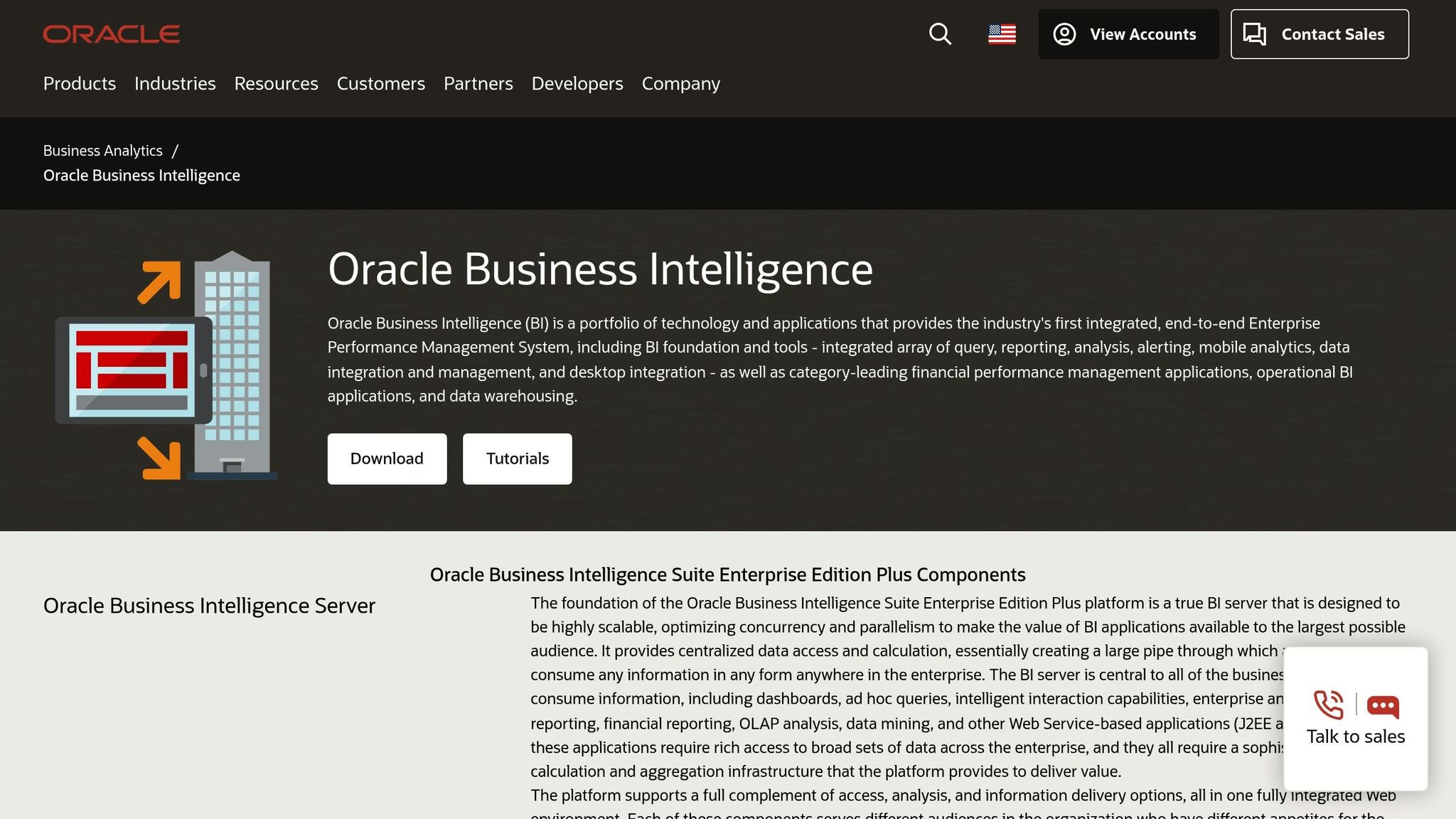
Oracle Business Intelligence (BI) is a financial modeling powerhouse, boasting a 4.1/5 rating from 90 reviews on GetApp. Designed for medium to large organizations, it combines advanced analytics with strong data integration capabilities, making it ideal for managing complex financial data environments.
The platform leverages AI and machine learning to deliver automated visualizations and predictive analytics, seamlessly integrating with Oracle Cloud Infrastructure (OCI) and Autonomous Data Warehouse (ADW) for scalability and enhanced security.
One of its standout features is its ability to transform intricate financial data into interactive, easy-to-understand visuals. Prashant Kumar Yadav, a Senior Consultant at Infosys Cobalt, highlights this strength:
"Oracle's reporting tools are more than just data crunchers; they are storytellers, decision-makers, and even predictors of the future."
This capability has practical applications across various industries. For example, multinational corporations use Oracle Analytics Cloud to consolidate financial operations and forecast sales by analyzing historical data alongside current customer trends.
Oracle BI also shines with its mobile reporting tools, which use natural language processing to provide real-time metrics on any device. A pharmaceutical sales team, for instance, relies on these features to optimize their sales strategies.
Pricing begins at $33 per processor per month, with implementation costs ranging from $100,000 to $1 million. Notably, 83% of users recommend Oracle BI.
System Analyst Roberto B. praises its versatility:
"A powerful and complete BI tool, with great integration with other ERP platforms, with hybrid premise as promised and a robust mobile platform."
However, its complex architecture does require dedicated training to maximize its potential. IT Administrator Clive M. emphasizes its analytical strengths:
"Oracle is great analytical tool with great functionalities and opportunities which makes it easier to analyze data using different scenarios."
For organizations with large-scale needs, Oracle BI offers advanced analytics, strong security measures, and seamless integration, making it a top choice for processing big data and IoT inputs.
6. Anaplan
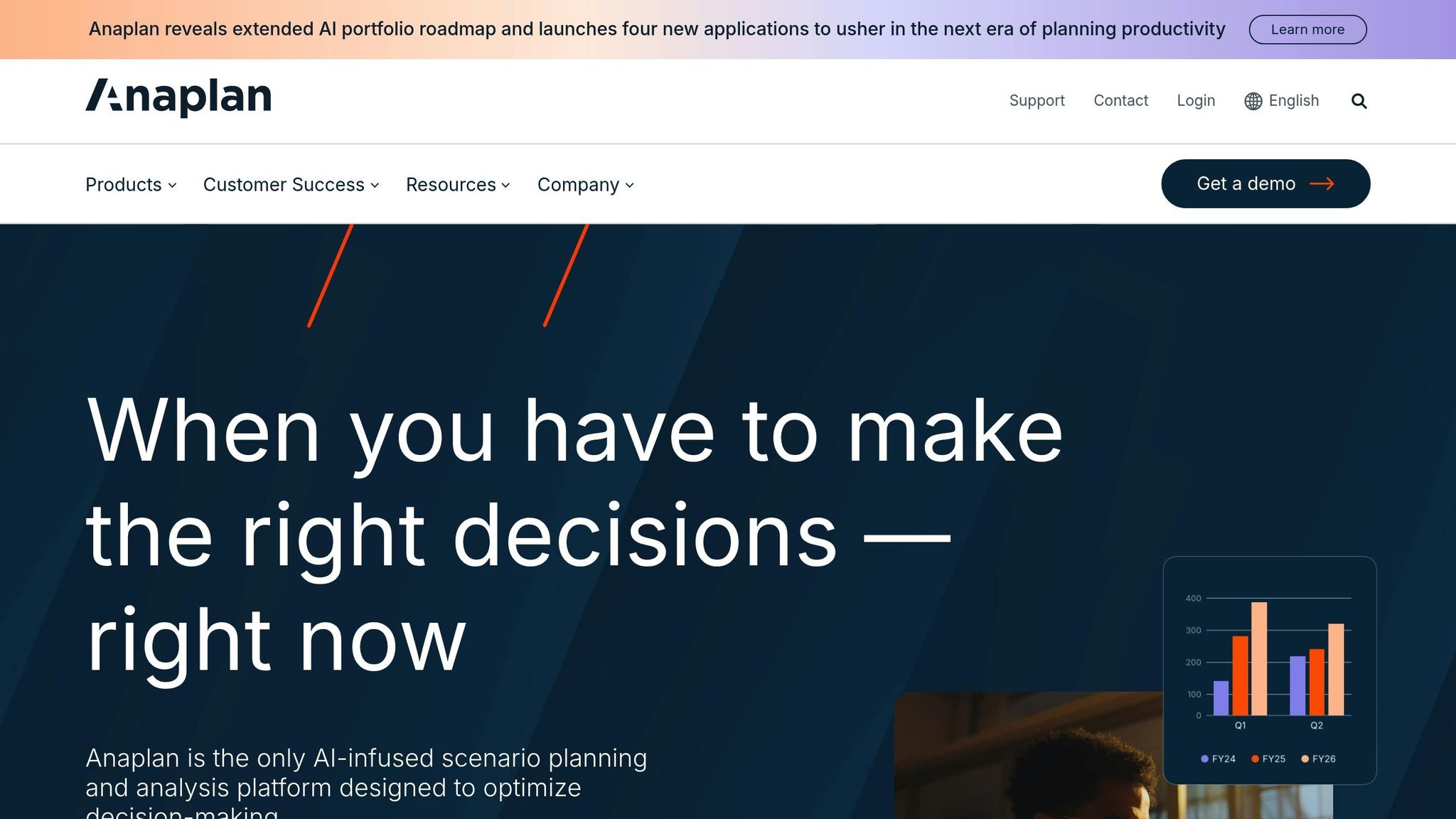
Anaplan's cloud-based platform has made waves in the enterprise planning space, earning a solid 4.5/5 rating based on 339 Gartner Peer Insights reviews. Powered by its Hyperblock® and Polaris calculation engines, Anaplan delivers in-memory processing that supports highly scalable models - perfect for large-scale enterprise needs. This technology keeps pace with the high standards set by other leading platforms in the industry.
With over 2,200 customers globally, Anaplan has quickly established itself as a market leader. Its strength lies in multi-dimensional modeling that spans various business functions. Impressively, 53% of its users come from companies generating over $1 billion in revenue.
The platform's Predictive Insights and PlanIQ features combine machine learning with intelligent forecasting, making it easier to optimize planning processes. Additionally, its real-time data integration simplifies financial consolidation, saving time and reducing errors.
Sean Dahlin, a Senior Financial Analyst at ServiceNow, highlights Anaplan's impact:
"With Anaplan, ServiceNow achieves growth at scale through the power of automation and standardization."
Pricing for Anaplan starts at $30,000 to $50,000 per year, depending on model complexity and data usage. While the cost may seem high, many users see it as a worthwhile investment. One verified enterprise user shares:
"Anaplan is not an over-the-counter solution, it's fully customizable and can be deployed across most business functions allowing for high value for money. Compared with Excel, it has a powerful calculation engine allowing to combine multiple complicated & large Excel spreadsheets in a single platform."
Anaplan is also stepping into the future with AI-driven conversational chat features designed for natural language queries. These advancements further solidify its role in reshaping enterprise financial planning.
The platform's effectiveness is reflected in its BARC ratings, scoring high marks in business value (9.1/10) and user experience (9.0/10). However, users should be aware that performance can slow when too many people are working on the platform simultaneously, making capacity planning a key consideration.
For organizations seeking advanced tools, Anaplan offers top-tier scalability (4.8/5), customization (4.8/5), and integration capabilities (4.4/5). It’s a powerful solution for businesses looking to streamline and elevate their planning processes.
sbb-itb-2e26d5a
7. Jedox
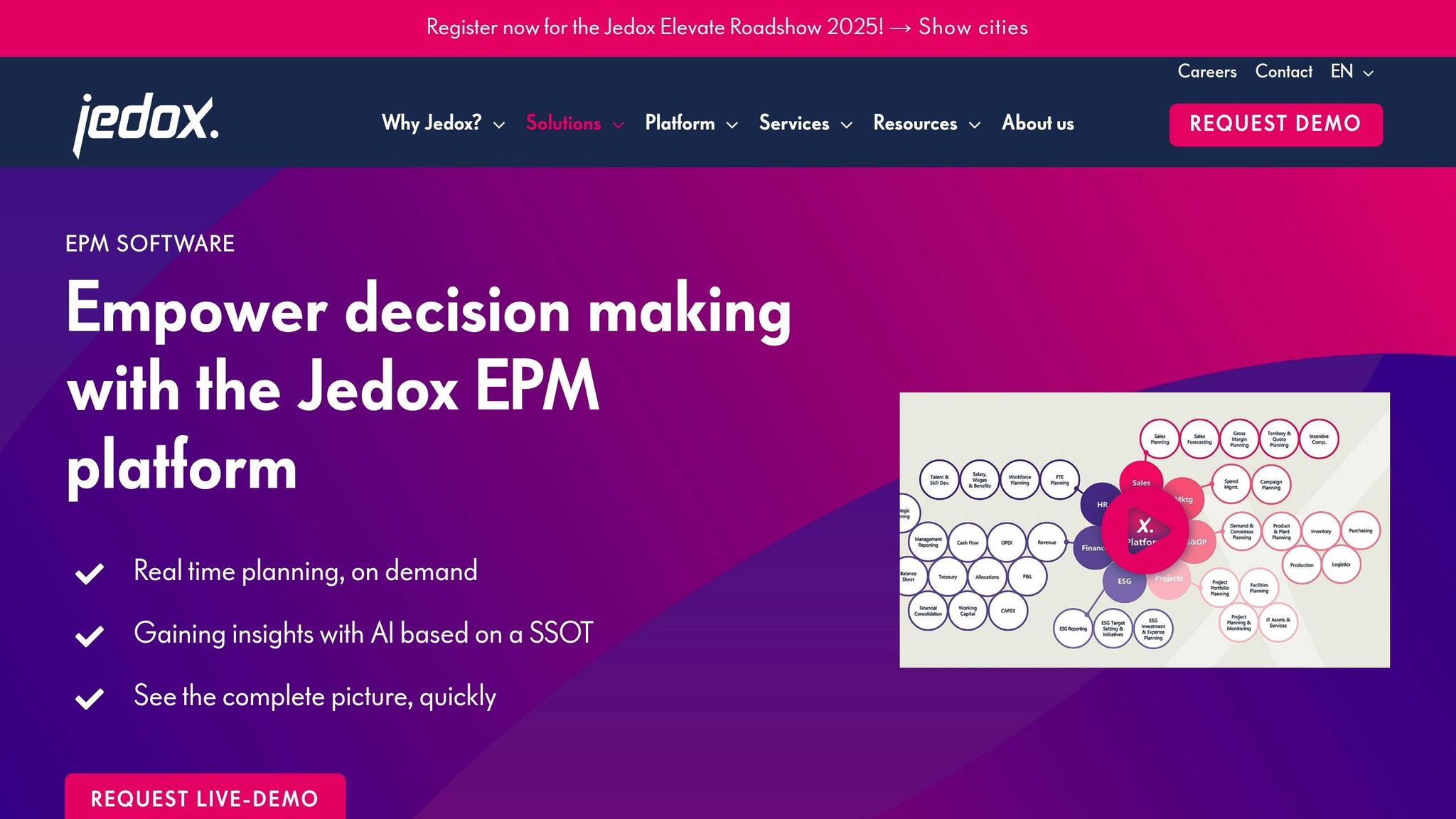
Jedox is a powerful Enterprise Performance Management (EPM) platform trusted by over 2,500 organizations across 140 countries. With a G2 rating of 4.3/5 based on more than 120 reviews, it blends advanced financial modeling tools with a familiar Microsoft Excel interface, making it accessible for finance professionals.
One of its standout features is AI-assisted Planning, which uses artificial intelligence to improve forecasting accuracy by 25–40%. This capability is especially beneficial for companies managing complex financial scenarios and multiple data sources.
A great example of Jedox in action comes from Lufthansa Systems, which implemented the platform in 2023:
"By consolidating financial data from over 30 global subsidiaries, we reduced our monthly closing process from 15 days to just 5 days while improving forecast accuracy by 28%."
Jedox boasts a 97% customer retention rate, thanks to its multi-dimensional modeling and high-performance in-memory database, which allow for real-time analysis of large datasets.
| Feature Category | Capabilities |
|---|---|
| Data Integration | Native connectors for SAP, Oracle, Salesforce |
| Planning Tools | Budgeting, forecasting, scenario modeling |
| Collaboration | Built-in workflows, approvals, notifications |
| Analytics | AI-powered predictions, real-time reporting |
These capabilities make Jedox a strong contender for businesses seeking competitive pricing and a solid return on investment.
Case studies further highlight Jedox's impact. For instance, Actelion implemented the platform across 30 countries:
"Our implementation across 30 countries resulted in a 70% reduction in planning cycle time, enabling sophisticated scenario planning capabilities that proved crucial during acquisition modeling."
Pricing starts at $45 per user/month for the Premium tier, with additional Enterprise options available for larger organizations. Companies using Jedox often see significant returns, with Nucleus Research reporting an average ROI of 267% and a 7.5-month payback period.
While implementation requires technical expertise, Jedox offers extensive support through its Jedox Academy and a network of over 250 global partners. Its robust security framework includes role-based access controls and detailed audit trails, ensuring compliance for organizations with strict regulatory requirements. Features like support for 25+ languages and multi-currency functionality make it particularly useful for global businesses managing complex, cross-border financial operations.
Jedox continues to push boundaries with recent developments, including expanded integration options and enhanced AI features. By focusing on predictive analytics and machine learning, the platform aims to further refine forecasting accuracy and maintain its leadership in financial modeling.
8. Jirav
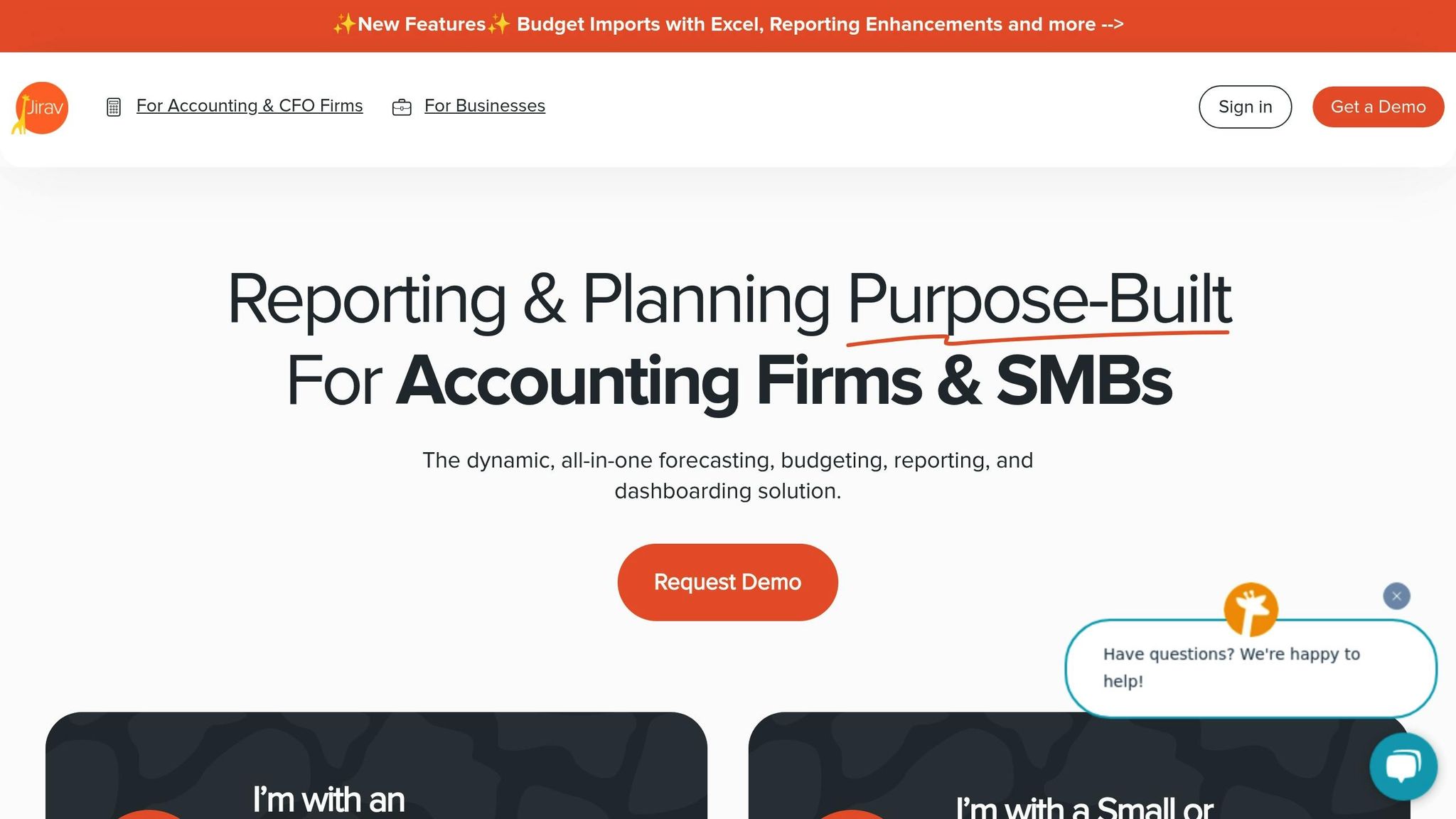
Jirav stands out as a top-tier financial modeling platform in 2025, particularly tailored for accounting firms that handle multiple clients. With user satisfaction scores of 4.9/5 on Capterra and 4.7/5 on G2, it combines powerful features with an easy-to-navigate interface.
One of Jirav's standout features is its visual reporting. The platform's interactive dashboards simplify complex data, making it easier to understand. Additionally, the scenario comparison tool lets users evaluate various business strategies side by side, giving a clear picture of potential outcomes.
| Feature Category | Capabilities |
|---|---|
| Key Features | Scenario planning, visual dashboards, collaborative modeling |
| Integration | QuickBooks, Xero, automated data syncing |
| Reporting | Customizable dashboards, KPI tracking, variance analysis |
| Collaboration | Multi-user access, role-based permissions, real-time updates |
Jirav's seamless integration with popular accounting tools like QuickBooks and Xero eliminates the need for manual data entry. Automated data syncing not only reduces errors but also frees up finance teams to focus on deeper analysis and strategic decision-making.
The platform's cloud-based design ensures accessibility for teams of all sizes, while its flexible interface supports even the most complex modeling needs. To help users get started quickly, Jirav provides detailed documentation and onboarding support, making it easy to unlock its full potential.
For teams managing multiple financial models, Jirav offers robust collaboration tools. Team members can work on different scenarios simultaneously, and role-based access controls ensure data security without hindering productivity. These features make it a go-to solution in today's fast-paced financial modeling environment.
While pricing details aren't publicly available, Jirav positions itself as a cost-efficient option for small to mid-sized businesses. It delivers advanced financial modeling tools without the complexity often associated with enterprise-level platforms. Its high user ratings and growing popularity in 2025 highlight its success in modernizing financial planning and making it more accessible. With its focus on collaboration and intuitive design, Jirav exemplifies the type of forward-thinking solutions shaping the future of financial modeling.
9. Planful
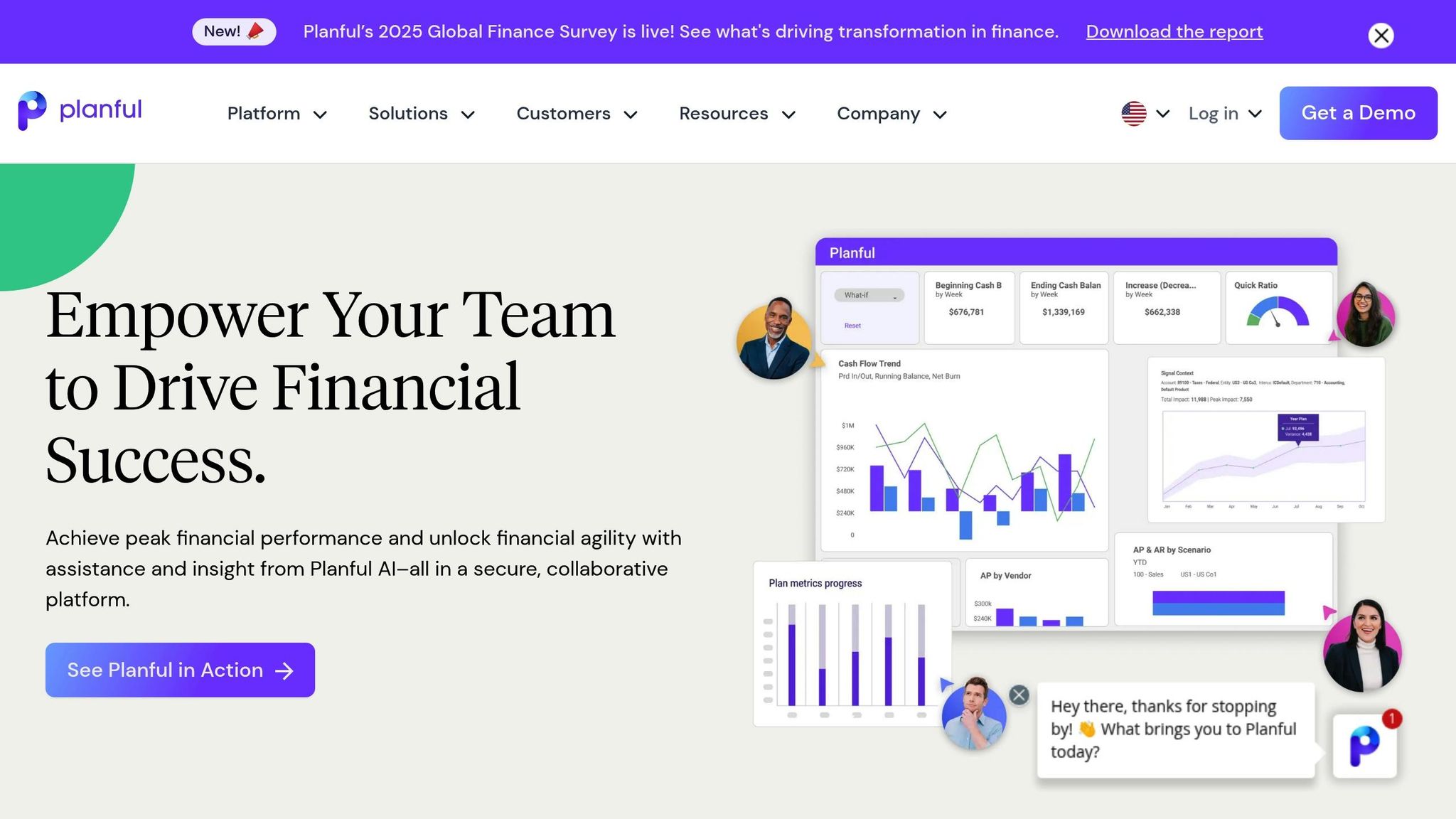
Planful has earned its place among top-tier financial modeling tools, thanks to over two decades of experience and a cloud-based platform tailored for mid-sized and enterprise businesses. Its long history of serving complex financial needs makes it a trusted choice for organizations looking for advanced modeling solutions.
What sets Planful apart is its comprehensive modeling capabilities, designed to handle intricate financial structures. Here's a quick breakdown of its key features:
| Feature Category | Capabilities | Benefits |
|---|---|---|
| Financial Planning | Headcount planning, customizable forecasting | Supports detailed workforce cost modeling |
| Consolidation | Multi-entity modeling, dimension scaling | Simplifies management of complex organizations |
| Workflow Integration | Excel-based modeling integration | Utilizes teams' existing spreadsheet skills |
Planful excels at managing sophisticated financial setups, particularly for companies with multiple divisions or global operations. Its dimension-scaling tool makes handling intricate models far more manageable, while its ability to consolidate financial data across entities is a major plus for large organizations.
However, onboarding Planful comes with some challenges. Implementation usually requires third-party consultants, which can extend the deployment timeline. Additionally, while the platform is powerful, its interface has a steeper learning curve, which may require extra training for new users. On G2, Planful holds a solid rating of 4.3/5, with users praising its consolidation and modeling capabilities despite the initial hurdles.
Interestingly, much of the modeling work is often still done in Excel before being integrated into Planful. This approach works well for teams already comfortable with spreadsheet-based workflows, making the transition smoother.
Organizations with multiple business units or those needing advanced headcount planning and financial consolidation will find Planful particularly useful. Its 20+ years of refinement and focus on complex modeling ensure it remains a strong contender for businesses prioritizing depth and scalability over immediate ease of use.
10. Domo
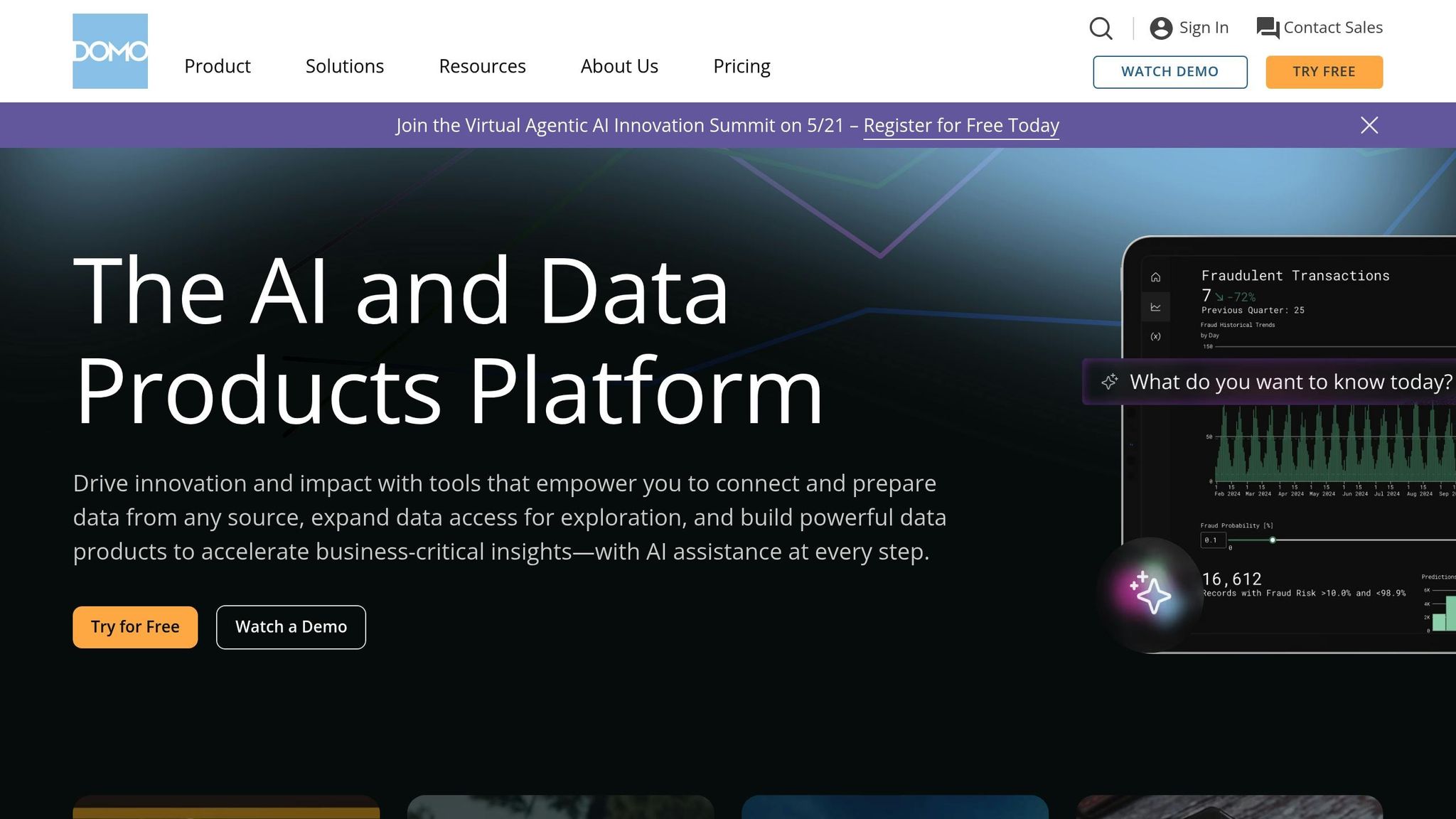
Domo is a cloud-based platform designed to handle complex financial modeling tasks with speed and efficiency. Thanks to its Adrenaline engine, users can analyze up to 100 billion rows of data in seconds, making it a go-to choice for organizations managing large and intricate financial datasets.
One of Domo's standout features is its extensive integration ecosystem, which includes over 1,000 pre-built connectors. These connectors make it easy to link Domo with a variety of financial data sources, ensuring seamless data consolidation and analysis. Here's a closer look at how Domo connects with key systems:
| Data Source Type | Examples | Benefits |
|---|---|---|
| Financial Systems | QuickBooks, Xero, NetSuite | Automated financial data consolidation |
| ERP Platforms | SAP, Oracle, Microsoft Dynamics | Real-time operational insights |
| Banking APIs | Payment processors, market data | Live financial tracking |
| Custom Sources | On-premises databases, CSV files | Flexible data importing |
Domo also simplifies data transformation with its "Magic ETL" tool, a drag-and-drop interface that requires no coding. For more advanced calculations, the "Beast Mode" feature allows users to create complex financial formulas directly within the platform. According to a Forrester Total Economic Impact study, companies using Domo have reported an average ROI of 434%, with a payback period of less than six months.
Pricing and Plans
Domo offers a range of pricing options to suit different needs. The Standard plan starts at $83 per user per month, while the Professional plan is priced at $160 per user per month (both billed annually). Enterprise plans are available with custom pricing tailored to specific requirements.
Security Features
Security is a top priority for Domo, which provides robust measures to protect sensitive financial data:
- SOC 1, SOC 2, and SOC 3 compliance certifications
- End-to-end encryption for data both in transit and at rest
- Role-based access controls to manage sensitive information
- Detailed audit logs for compliance tracking
Mobile Accessibility and Efficiency
Domo's mobile-first design ensures that financial professionals can access dashboards and models from any device. This flexibility is particularly useful for teams spread across different locations. The platform's real-time processing capabilities have also been a game-changer, helping businesses cut report creation time by as much as 80%.
Learning Curve and Training
While Domo offers a wide array of advanced features, it does come with a steeper learning curve. To help users get up to speed, Domo University provides comprehensive training and resources.
Domo's reputation as a Leader in the 2024 Gartner Magic Quadrant for Analytics and Business Intelligence Platforms further highlights its position as a top-tier option for companies looking for a powerful and versatile financial modeling solution.
Platform Features Comparison
To help you choose the right financial modeling platform, let's break down the key features, capabilities, and pricing of the top options. Differences in AI tools, integration flexibility, and compliance features can play a big role in your decision.
Core Features and Capabilities
| Feature Category | Top Platforms | Key Capabilities |
|---|---|---|
| AI & Automation | Visbanking BIAS, Cube | Forecasting, anomaly detection, and data automation |
| Integration | Domo, Oracle BI | Enterprise connectors and real-time synchronization |
| Compliance | Oracle BI, Planful | SOX, GDPR, HIPAA compliance with audit trails |
| Collaboration | Finmark, Jirav | Real-time co-editing and role-based user access |
| Visualization | Jirav, Domo | Customizable dashboards and dynamic reporting |
These features influence both the price and the overall value of each platform.
Pricing Structure Analysis
Here's a quick look at how pricing stacks up:
- Mid-Market Platforms: Options like Jirav and Cube typically range from $500 to $2,000 per month.
- Enterprise Solutions: Platforms such as Oracle BI and Planful are priced higher, generally $2,000 to $5,000+ per month.
Integration Capabilities
Integration is a critical factor when selecting a platform. Cube offers seamless native connectivity with most tech stacks, making it easier to integrate into existing workflows. On the other hand, Planful often requires initial Excel processing before full system integration happens.
These platforms also use AI tools to improve forecasting accuracy, which can save time and reduce errors.
AI and Machine Learning Features
AI tools vary across platforms, offering unique benefits:
- Visbanking BIAS: Achieves up to 40% risk reduction with predictive analytics.
- Cube: Automates data workflows but has some limitations with dimensional scaling.
- Planful: Offers flexible forecasting options tailored to specific needs.
User Experience and Ratings
Here’s how users rate these platforms on popular review sites:
| Platform | Capterra Rating | G2 Rating |
|---|---|---|
| Visbanking BIAS | 4.8 | 4.7 |
| Finmark | 5.0 | 4.6 |
| Jirav | 4.9 | 4.7 |
| Cube | 4.6 | 4.5 |
| Planful | – | 4.3 |
Scalability Considerations
For large-scale operations, Anaplan stands out with its multi-dimensional modeling capabilities, making it a strong choice for enterprises. However, Cube may struggle with rapid scaling or managing international operations.
Security and Compliance Features
If security and compliance are top priorities, enterprise-grade platforms like Oracle BI and Planful deliver:
- 256-bit AES encryption
- Two-factor authentication
- SOC 1 and SOC 2 Type II certifications
- Role-based access controls
- Detailed audit trails
These features ensure that sensitive financial data stays protected, while comprehensive compliance measures address regulatory requirements.
Mobile Accessibility
Modern platforms prioritize mobile usability, offering designs optimized for tablets and smartphones. This ensures financial teams can check reports and metrics on the go, no matter where they are working.
Summary
The financial modeling landscape in 2025 is marked by advanced, scalable solutions tailored to various market segments.
Enterprise-Grade Solutions
- Oracle BI and Anaplan stand out for their multi-dimensional modeling capabilities.
- Planful and Domo prioritize robust security features.
- Visbanking BIAS integrates AI-driven analytics for deeper insights.
Mid-Market Solutions
- Finmark and Jirav focus on enhancing collaboration among teams.
- Cube offers seamless integration with existing systems.
- Pricing and features are designed to scale alongside business needs.
These platforms help businesses align their needs with specific features. For an in-depth comparison, check out the Best Investing Tools Directory: https://bestinvestingtools.com.
Key Selection Criteria for 2025
| Business Size | Recommended Platforms | Primary Benefits |
|---|---|---|
| Startups | Finmark, Jirav | Easy to use, budget-friendly |
| Mid-Market | Cube, Macabacus | Excel integration, scalable functionality |
| Enterprise | Oracle BI, Anaplan | High-level security, advanced modeling |
The industry is also making strides in predictive analytics and automation. Platforms like Visbanking BIAS and Cube are at the forefront of AI-powered innovation, further enhancing their value.
When choosing the right platform, keep these factors in mind:
- Integration: How well does it work with your current systems?
- Scalability: Can it grow with your business?
- Security: Does it meet your compliance needs?
- Collaboration: Are team-friendly features included?
- AI and Automation: Does it leverage advanced technology?
With regular updates and new features, these platforms are evolving to meet the ever-growing demands of financial modeling in 2025.
FAQs
What should businesses consider when choosing a financial modeling platform in 2025?
When choosing a financial modeling platform in 2025, businesses should prioritize user-friendliness, customization options, and how well the platform integrates with their current tools. Pricing, scalability, and whether the platform caters to your industry or specific use cases are also key factors to weigh.
Look for platforms that provide strong customer support, frequent updates, and advanced tools like scenario analysis, forecasting, and real-time data integration. Carefully evaluating these elements will help you find a solution that fits your financial objectives and operational needs.
How do AI and machine learning improve financial modeling platforms like Visbanking BIAS and Cube?
AI and machine learning are transforming financial modeling platforms by taking over intricate calculations, spotting patterns in data, and boosting the precision of forecasts. Platforms such as Visbanking BIAS and Cube benefit greatly from these technologies, as they simplify the process of analyzing massive datasets and deliver actionable insights at a faster pace.
What’s more, AI-driven tools can adjust to shifting market conditions, providing sharper predictions and more dynamic scenario modeling. This empowers users - whether they’re managing budgets, projecting revenue, or evaluating investments - to make decisions with a higher level of confidence.
How do financial modeling platforms for startups differ from those designed for large enterprises in terms of features and pricing?
When it comes to financial modeling platforms, startups and large enterprises have very different needs - and the tools they use reflect that.
For startups, the focus is on keeping things simple, affordable, and easy to scale. These platforms often come with intuitive interfaces, basic forecasting tools, and integrations with popular accounting software. They're designed to help small teams work efficiently without breaking the bank. Pricing is usually flexible, with options like subscription plans or pay-as-you-go models, making them accessible for organizations with tighter budgets.
In contrast, platforms tailored for large enterprises are built to handle more complex demands. They offer advanced features such as detailed scenario analysis, sophisticated financial forecasting, and tools for seamless collaboration across departments. These platforms are equipped to manage large datasets and support intricate workflows. However, this level of functionality and enterprise-grade security comes at a higher cost.
Ultimately, the right choice depends on your organization's size, specific requirements, and budget.



